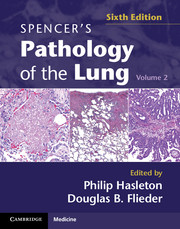Book contents
- Frontmatter
- Dedication
- Contents
- Contents
- Contributors
- Foreword to the First Edition
- Preface to the Sixth Edition
- Acknowledgements
- Chapter 1 The normal lung: histology, embryology, development, aging and function
- Chapter 2 Lung specimen handling and practical considerations
- Chapter 3 Congenital abnormalities and pediatric lung diseases, including neoplasms
- Chapter 4 Pulmonary bacterial infections
- Chapter 5 Pulmonary viral infections
- Chapter 6 Pulmonary mycobacterial infections
- Chapter 7 Pulmonary mycotic infections
- Chapter 8 Pulmonary parasitic infections
- Chapter 9 Acute lung injury
- Chapter 10 Interstitial lung diseases
- Chapter 11 Metabolic and inherited connective tissue disorders involving the lung
- Chapter 12 Hypersensitivity pneumonitis
- Chapter 13 Sarcoidosis
- Chapter 14 Occupational lung disease
- Chapter 15 Eosinophilic lung disease
- Chapter 16 Drug- and therapy-induced lung injury
- Chapter 17 Chronic obstructive pulmonary disease and diseases of the airways
- Chapter 18 Pulmonary vascular pathology
- Chapter 19 Pulmonary vasculitis and pulmonary hemorrhage syndromes
- Chapter 20 The pathology of lung transplantation
- Chapter 21 The lungs in connective tissue disease
- Chapter 22 Benign epithelial neoplasms and tumor-like proliferations of the lung
- Chapter 23 Pulmonary pre-invasive disease
- Chapter 24 Epidemiological and clinical aspects of lung cancer
- Chapter 25 Lung cancer staging
- Chapter 26 Immunohistochemistry in the diagnosis of pulmonary tumors
- Chapter 27 Adenocarcinoma of the lung
- Chapter 28 Squamous cell carcinoma of the lung
- Chapter 29 Large cell carcinoma and adenosquamous carcinoma of the lung
- Chapter 30 Salivary gland neoplasms of the lung
- Chapter 31 Neuroendocrine tumors and other neuroendocrine proliferations of the lung
- Chapter 32 Sarcomatoid carcinomas and variants
- Chapter 33 Mesenchymal and miscellaneous neoplasms
- Chapter 34 Pulmonary lymphoproliferative diseases
- Chapter 35 Metastases involving the lungs
- Chapter 36 Diseases of the pleura
- Index
- References
Chapter 28 - Squamous cell carcinoma of the lung
Published online by Cambridge University Press: 05 June 2014
- Frontmatter
- Dedication
- Contents
- Contents
- Contributors
- Foreword to the First Edition
- Preface to the Sixth Edition
- Acknowledgements
- Chapter 1 The normal lung: histology, embryology, development, aging and function
- Chapter 2 Lung specimen handling and practical considerations
- Chapter 3 Congenital abnormalities and pediatric lung diseases, including neoplasms
- Chapter 4 Pulmonary bacterial infections
- Chapter 5 Pulmonary viral infections
- Chapter 6 Pulmonary mycobacterial infections
- Chapter 7 Pulmonary mycotic infections
- Chapter 8 Pulmonary parasitic infections
- Chapter 9 Acute lung injury
- Chapter 10 Interstitial lung diseases
- Chapter 11 Metabolic and inherited connective tissue disorders involving the lung
- Chapter 12 Hypersensitivity pneumonitis
- Chapter 13 Sarcoidosis
- Chapter 14 Occupational lung disease
- Chapter 15 Eosinophilic lung disease
- Chapter 16 Drug- and therapy-induced lung injury
- Chapter 17 Chronic obstructive pulmonary disease and diseases of the airways
- Chapter 18 Pulmonary vascular pathology
- Chapter 19 Pulmonary vasculitis and pulmonary hemorrhage syndromes
- Chapter 20 The pathology of lung transplantation
- Chapter 21 The lungs in connective tissue disease
- Chapter 22 Benign epithelial neoplasms and tumor-like proliferations of the lung
- Chapter 23 Pulmonary pre-invasive disease
- Chapter 24 Epidemiological and clinical aspects of lung cancer
- Chapter 25 Lung cancer staging
- Chapter 26 Immunohistochemistry in the diagnosis of pulmonary tumors
- Chapter 27 Adenocarcinoma of the lung
- Chapter 28 Squamous cell carcinoma of the lung
- Chapter 29 Large cell carcinoma and adenosquamous carcinoma of the lung
- Chapter 30 Salivary gland neoplasms of the lung
- Chapter 31 Neuroendocrine tumors and other neuroendocrine proliferations of the lung
- Chapter 32 Sarcomatoid carcinomas and variants
- Chapter 33 Mesenchymal and miscellaneous neoplasms
- Chapter 34 Pulmonary lymphoproliferative diseases
- Chapter 35 Metastases involving the lungs
- Chapter 36 Diseases of the pleura
- Index
- References
Summary
Introduction
Although squamous cell carcinoma (SCC) of the lung has been supplanted by adenocarcinoma as the most common histological type of non-small cell carcinoma (NSCLC) in pockets of the developed world, this carcinoma is by no means a rare entity. In fact, incidence rates for SCC in men and women still surpass those of adenocarcinoma in several European countries. The tobacco-related malignancy probably represents at least 30% of newly diagnosed lung cancers worldwide, but exact figures are difficult to ascertain. Since SCC has higher resectability and perhaps cure rates than other lung carcinomas, this subtype is overrepresented in surgical series and underrepresented in autopsy series. Basic pathogenetic mechanisms have been known for decades and our ability to monitor high-risk patients has greatly improved (see Chapters 23 and 24). Given the recent emphasis on distinguishing SCC from adenocarcinoma for therapeutic reasons, this chapter will present our current understanding of this carcinoma and highlight recent developments in diagnosis.
Classification and cell of origin
The 2004 World Health Organization (WHO) Classification is the globally recognized lung tumor classification scheme. The classification is descriptive and almost entirely based on light microscopic features. Squamous cell carcinoma is a malignant epithelial tumor with keratinization and/or intercellular bridges. Although many morphological variants have been described, the WHO limits the classification to papillary, clear cell, small cell, and basaloid subtypes (Table 1). Squamous cell carcinoma may also be combined with adenocarcinoma or small cell carcinoma (SCLC) in addition to other malignancies. A diagnosis of adenosquamous carcinoma requires that at least 10% of the SCC tumor features either an unequivocal glandular component or alternatively at least 10% of an obvious adenocarcinoma contains unequivocal keratinization or intercellular bridges. Of note, rare mucin vacuoles can be seen in typical SCC. Squamous cell carcinoma seen in association with SCLC is termed combined SCLC (see Chapter 31).
- Type
- Chapter
- Information
- Spencer's Pathology of the Lung , pp. 1093 - 1113Publisher: Cambridge University PressPrint publication year: 2000



